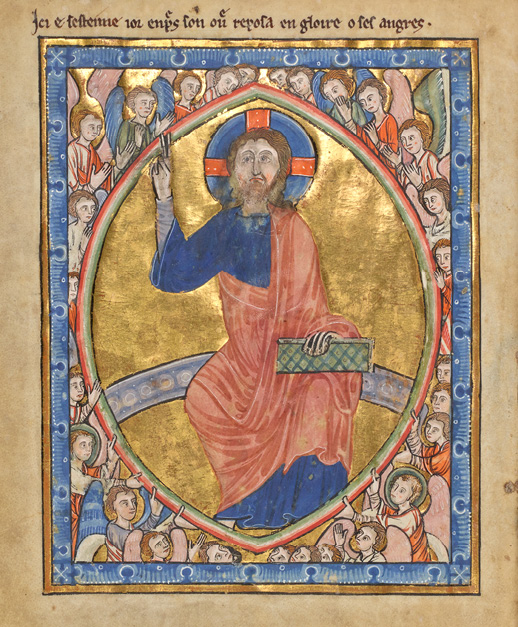This article is taken from PN Review 283, Volume 51 Number 5, May - June 2025.
Pictures from a Library
Marks, Scrapings and Spittle in a Medieval Picture Bible

As Michel de Certeau observes, to read is to receive a text ‘from someone else without putting one’s own mark on it’. But do readers pass through texts and leave without a trace? After all, texts often live in books (at least before the digital age) and a book by definition ‘constitutes a haptic medium … which comes into being during manipulation’ (Kathryn Ross). The somatic experience of reading can often be detected as a residue through the ‘marks of use’ a reader leaves behind. These cryptic vestiges take myriad forms and can be read as records of their past users’ reading habits.
Rylands French Manuscript 5 is a handheld Picture Bible dating from the thirteenth century. Measuring 185 x 145 mm, it contains forty-eight full-page miniatures which shimmer with rainbow chromatics, lavishly embellished with gold, the work of a virtuoso illuminator versed in the Channel style. Recounting Old Testament scenes from the books of Genesis and Exodus, it deploys its scriptural narrative almost exclusively in visual form and contains evidence of a high level of engagement between the book and its medieval readers.
As the leaf before us demonstrates, legends in the Picardian dialect have been added by a reader, or one of their scribes, in defiance of its original design. Crammed inelegantly into the margins these plodding explanations conjure someone in need of a linguistic framework to help extrapolate the meaning of the book’s visual narrative.
Other readers, by contrast, have found the Bible’s images all too legible. As Molly Lewis notes, medieval images ‘look back’ at their readers so the malignant deeds sometimes pictured in this book (such as Caine’s murder of Abel, folio 8) were deemed to have the power to cause harm. To mitigate ‘the fear of such ocular contagion’ (Lewis) one reader, with zealous deliberation, has scraped away the faces of some of the figures pictured in sinful acts. So a performance of iconoclastic obliteration offers evidence of a reader’s beliefs and the role this book played in their expression.
Even a humble blotch can offer a clue to readerly habits, as in the image shown here. Surrounded by rapt, adoring angels, God, resplendent in majesty, rests from his labours and blesses his work on the seventh day of creation. Our attention is drawn to a smudge around the Deity’s mouth, likely left by the lips of an erstwhile reader performing an act of veneration through the medium of an actual and oft-repeated kiss. Targeted to the mouth of God we can rightly infer that this ritual stems from an aristocratic context for the kissing of one’s liege on the mouth as an act of making fealty, to mark a ‘record written on the lips just like an oath spoken with them’ (Michael Camille).
So, as an art reading is ‘anything but passive’ and sometimes very visible, as we catch a glimpse of its ‘ephemeral dance’ (de Certeau) through the hint of a mere stain.
Rylands French Manuscript 5, thirteenth century. (© The John Rylands Research Institute and Library, The University of Manchester, 2025)
This article is taken from PN Review 283, Volume 51 Number 5, May - June 2025.
